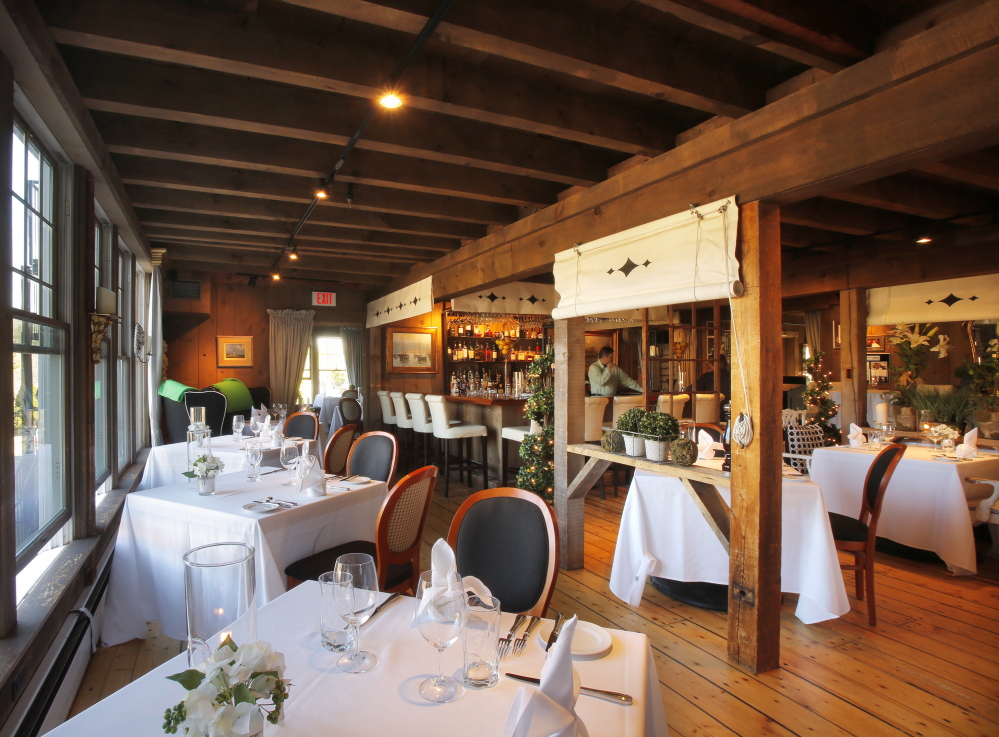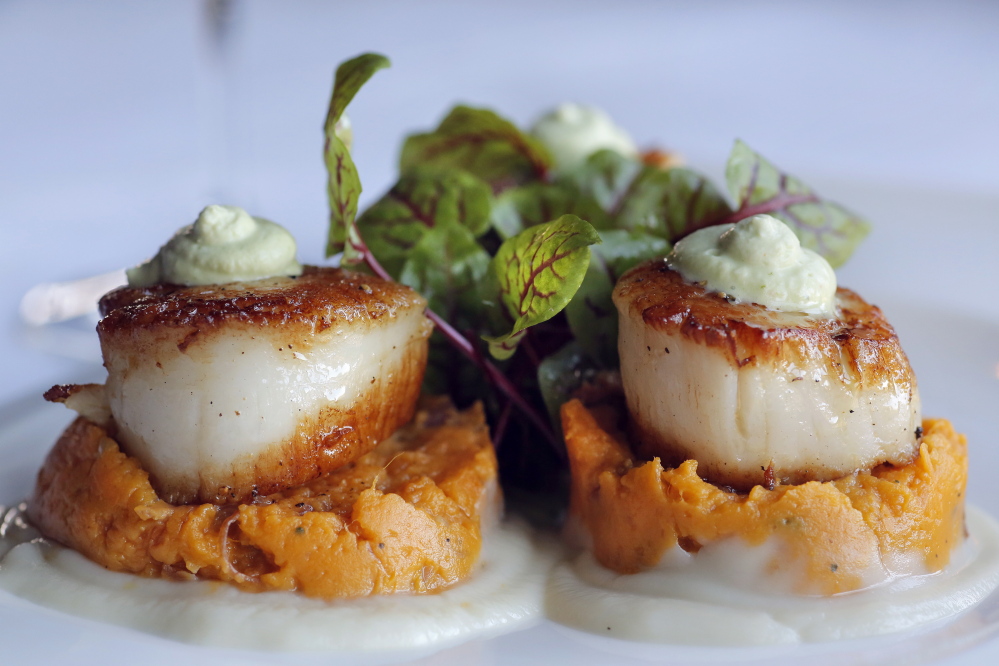On the Marsh Bistro reminds me of one of those boutique hotels where everything – from the bottle of sparkling water on the nightstand to the plush, terry cloth robe in the closet – can be yours for a steep price. “All that you see here is for sale,” general manager John Redlon explains. And that’s saying something.
The two dining rooms downstairs and the larger one upstairs overflow with upholstered furniture, patterned pillows, shell-lined mirrors, ornate wooden chandeliers, lighted topiaries, silk flowers, cachepots, massive metal lanterns and tiny gilt-framed paintings. (Denise Rubin, who bought the property in 2000, is an interior designer who splits her time between Maine and the Netherlands.) Throw in the collection of glassware, silver and oil lamps on every dining table, and the message is abundantly clear: More is more at this self-consciously upscale Kennebunk restaurant.
That includes executive chef Jeffrey Savage’s self-described “European country cuisine,” which spotlights dishes such as foie gras and lobster pie that are exorbitantly priced and enthusiastically garnished with everything from “hydroponic red-veined sorrel” and “goji berry syrup” to “champagne cream” and “candied hazlenuts.” Even the butter is decorated, with scarlet strands of what the helpful waiter identified as “Thai chili threads.”
This kitchen wields excess in order to impress. On occasion, the cuisine is as impressive as the hype.
Take the appetizer of pan-roasted rope cultured mussels ($18), among the best I’ve tried anywhere. Served in a large white bowl and easily a meal in itself, the mussels are tender and succulent, and the cream sauce – flavored with white wine, large chunks of tomato and mild whole cloves of roasted garlic – is both rich and intensely satisfying. A friend across the table sat nearly silent as she pulled a few mussels from the aromatic liquid, then dunked slices of the house-made sourdough back into the steaming bowl. Finally, she looked up and said, “Can I take this home and have it for breakfast tomorrow?” The main ingredient may have been shellfish, but the breakout star of the show was the sauce.
A serving of grilled Hudson Valley foie gras looked just as luscious, appearing on a plate with a small triangle of toast, a scattering of sugar-coated nuts and a few of those red-veined sorrel leaves. Unfortunately, the liver was a letdown – and at $23 a seriously expensive letdown. While the exterior was beautifully caramelized and tasted slightly sweet, the interior was fibrous because the lobe hadn’t been thoroughly deveined. It had little of the buttery silkiness that distinguishes fine foie. I wished I’d stuck to the mussels.
Chef Savage demonstrated his strengths more clearly with the roasted duck ($36). Served with a few stalks of spicy broccoli rabe, a tiny mache salad and a spoonful of root vegetable mash, the meat was mild and juicy with none of the gaminess that can characterize duck, and – impressively – very little fat, and the skin was a knockout: golden brown and fabulously crispy. I couldn’t decide which I liked more, the breast meat or the skin. Luckily, the ample serving offered plenty of both.
Nearly as good were the pan-seared scallops, which seemed to float in a sea of color on a plate with (more) red-veined sorrel, a pale sunchoke puree, dollops of compound butter flecked with herbs and vivid orange sweet potato hash. Though heavily camouflaged by that elaborate presentation, the scallops were tasty. Our waiter had been careful to ask how my friend liked them prepared, “Medium and translucent in the center or cooked through?” She requested fully cooked, and they arrived just as ordered: brown and crusty on the outside, sweet and warm within, with a supple texture and a fresh flavor that left us wanting more. Still, I kept considering the ticket price: $41? That seemed – and seems – steep for three sea scallops, however plump.
Maybe it was the richness of the cream sauce with the mussels or that crispy duck skin – or a growing sense of sticker shock – but I was rapidly losing my appetite. Still, the dessert menu intrigued me. While the starters and large plates almost all trumpeted elegance, the desserts appeared decidedly casual, with suggestions such as bread and butter pudding ($12), a lime bar with lemon sorbet ($11) and “Our S’Mores,” ($11), which the waiter told me featured house-made marshmallows and graham crackers.
I tried the s’more, which, regrettably, delivered less – less flavor, less satisfaction and less balance than the rest of the meal. The single marshmallow rectangle looked attractive tilted up on the plate, but it was gummy and unpleasantly sweet. The house-made graham, too, fell flat. Even the scoop of cinnamon ice cream failed to rescue this upscale s’more. Its one saving grace? The meltingly smooth spoonful of Valrhona chocolate sorbet standing in for the campfire Hershey’s chocolate bar.
Dinner at On the Marsh is an exercise in extravagance, and you’ll have to decide how much you’re willing to pay for the experience. My suggestion? Splurge on the mussels, indulge in the duck and skip anything s’more.
Just because a terry cloth robe hangs in the closet doesn’t mean you have to buy it and take it home.
James H. Schwartz has covered food, travel and architecture for The Washington Post, Downeast, Coastal Living and Southern Living magazines for more than 30 years. Long a commuter between Portland and Washington, D.C., he retired from his job as vice president at the National Trust for Historic Preservation in 2013 and relocated to Maine.
Send questions/comments to the editors.



